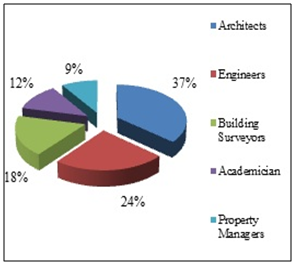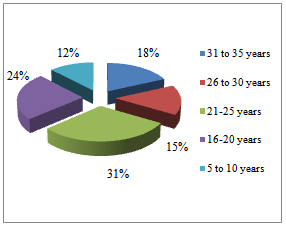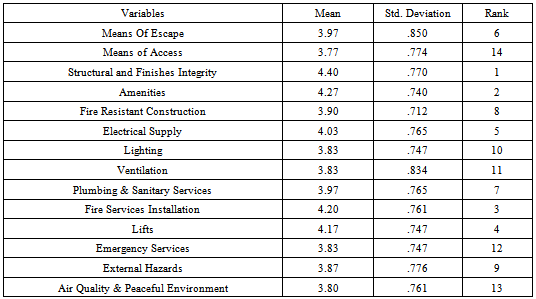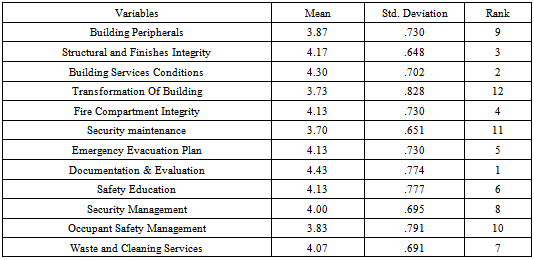-
Paper Information
- Paper Submission
-
Journal Information
- About This Journal
- Editorial Board
- Current Issue
- Archive
- Author Guidelines
- Contact Us
Journal of Safety Engineering
p-ISSN: 2325-0003 e-ISSN: 2325-0011
2013; 2(1): 1-9
doi:10.5923/j.safety.20130201.01
Factors Contributing Building Safety and Health Performance of Low Cost Housing in Malaysia
A. Ramli, Z. A. Akasah, M. I. M. Masirin
Faculty of Civil and Environmental Engineering, UniversitiTun Hussein Onn Malaysia (UTHM), 86400,Parit Raja, BatuPahat, Johor, Malaysia
Correspondence to: A. Ramli, Faculty of Civil and Environmental Engineering, UniversitiTun Hussein Onn Malaysia (UTHM), 86400,Parit Raja, BatuPahat, Johor, Malaysia.
| Email: |  |
Copyright © 2012 Scientific & Academic Publishing. All Rights Reserved.
The implementation of safety and health measures on building should be addressed during their life cycles to improve the occupants’ quality of life. However, information concerning the health and safety performance of buildings is not always readily available. This paper aims to determine and identify the factors contributing to safety and health performance of low cost housing in Malaysia. The research first identified the critical factors through a literature review of current safety and health practices from journals, thesis and articles books in order to interpret the factors from a global perspective. A total of fifty questionnaires were then distributed to relevant respondents such as academician, architects, engineers, building surveyors and property managers. In total, 33 completed questionnaires formed a database for descriptive and ranking analysis. The findings of the study revealed that the reliability of the instruments were greater than 0.80. A preliminary finding concluded three factors that the most dominant building design factors contributing to safety and health performance of low cost housing in Malaysia were structural and finishes integrity, amenities and fire services installation. Meanwhile, it was found that three of the most building management factors were documentation and evaluation, building services and structural and finishes integrity. Collectively, results provide evidence that the instruments are reliable in the Malaysian context. However, a bigger sample would be needed to represent the larger population of construction practitioners in Malaysia.
Keywords: Safety and Health, Low Cost Housing, Preliminary, Ranking Analysis
Cite this paper: A. Ramli, Z. A. Akasah, M. I. M. Masirin, Factors Contributing Building Safety and Health Performance of Low Cost Housing in Malaysia, Journal of Safety Engineering, Vol. 2 No. 1, 2013, pp. 1-9. doi: 10.5923/j.safety.20130201.01.
Article Outline
1. Introduction
- It is well known how the construction sector in Malaysia contributed an enormous influence over economic activity, employment and growth rates. Currently, demand on residential especially on high rise residential development is always proportional to the increase in population density[1]. Assessment by Administrative Districts, Malaysia[2] showed that population density in Kuala Lumpur for 2010 is 7089 per unit of land area. Viewed from the end of 2011, Malaysian Investment Development Authority[3]reported a total of 1,422 housing projects excluding commercial buildings were approved with total investments amounting to RM16.9 billion.This figure proved the rapid urbanizationand modernization of Malaysia have increased the demand for safe, healthy and comfort living environment. Thus sustainable development and management must have engineering, managerial, financial and intelligent features and capability to respond to the rapid changing pace of technology in design and management[4]. Housing conditions is an important factor for health, safety and sustainability of built environment. Direct effects of poor housing has been identified as a structural deterioration, falling building fragments, deficiencies in fire safety provisions and slope failures, posed various hazards, respiratory symptoms and mental health problems[5][6]. In Malaysia, unsatisfactory housing conditions and reluctance of property management to carry out safety and health inspections are evidenced by the large number of complaints and reports about the danger and accidents from buildings[7]. A study conducted by Karim[8] pertaining to low cost housing quality in Shah Alam, Malaysia. He found that the performance of low cost housing is influenced to various issues such as quality and materials of construction, sanitary system, facilities provided, location, maintenance and social problems. A study by Isnin, Ramli, Hashim, and Ali[9], indicates that the residents of low cost terrace housing in Shah Alam, Malaysia were generally not satisfied with their housing conditions and environments. The construction activities, materials used cleanliness, aesthetic value, safety, privacy and amenities caused problems and risk affecting social health and the environment.More effort is necessary to boost this application especially towards the safety of buildings. Comprehensive ways, tools and concept must be develop to determine performance indicators and criteria for safety and health building, focusing in general on the prevention of safety and health problems[10],[11]. It needs a comprehensive understanding of the building factors for built environment hazards and for the purpose of the initial screening to evaluate building safety and health performance. Thus, there is a need for more research on developing an appropriate frame work for low cost housing in Malaysia. These situations were the starting point to survey the literature and extract a common framework for theory and systematically implementation in Malaysia. Therefore, the main objective of this research was to identify the main factors contributing safety and health performance of low cost housing in Malaysia that have been described by other researchers. These findings will help in the determining the appropriate instrument to be used in the Malaysian context according to local design, construction quality, climate, environment conditions and the use of existing buildings. The paper commences with a background review of building safety and health research relating to the construction industry and explores documented building safety and health practice by others researchers. This is followed by a description of the survey design and administration. The survey findings are then presented and discussed. Finally, conclusions are drawn andrecommendations are made.
2. General Background of Building Safety and Health
- For many years, a variety of building performance assessment methods mainly focusing on the housing quality have been practiced in other countries especially in Hong Kong, China and Australia. These schemes are Building Environmental Assessment Method (HK-BEAM), Building Safety and Conditions Index (BSCI), Building Quality Assessment (BQA) and Housing Performance Evaluation Model (HPEM), Standard of House Performance Appraisal (SHPA) and Comprehensive Environmental Performance Assessment Scheme (CEPAS). There are many methods to survey the condition of building, ranging from fail type certification, simple additive and weighed additive[12]. In particular, the purposes of building performance assessment are to measure housing quality using performance indicators to be consideredin improving the quality of the built environment[5][13][14]. In the following section, the six schemes reviewed include comparison of the schemes based on the purpose, scope of assessment and targeted building groups as shown in Table 1. In recent years, in the wave of housing industry, many countries have to go through in practices to developed building performance assessment schemes in order to improve their buildings quality. These performance assessments are selected to be reviewed as it concerns to high rise or dwelling types of housing.Hong Kong is the most densely built environment city in the world. A safe, healthy and comfortable livingenvironment that meets the economic, social and environment quality of the community is of pivotal importance to the smooth running of the city. Basically, there are two assessment schemes, one for health (the Building Health and Hygiene Index, BHHI) and the other for safety (the Building Safety and Conditions Index, BSCI). The BSCI and BHHI are essentially an arithmetic weighted average of the ratings of all building factors that have a bearing on the safety and health of a residential building[6],[17].In this regard, building factors are grouped into five categories, namely architecture, building services, external environment, operation and maintenance and management approaches. According to Ho et al.[22], who conducted a health and safety performance assessment of one hundred forty (140) apartments buildings in Hong Kong found a strategic management approaches is the important factor that should consider in order to improve buildings and living environment. With this approach, the public, building owners, developers and government bodies can make more informed to make worthwhile improvements to the safety, health and sustainability housing.
|
 | Figure 1. Variables of Building Safety and Health Framework (BSHF) |
3. Factors Contributing Building Safety and Health Performance of Low Cos Housing in Malaysia
- The implementation of safety measures should be addressed in the design and management process. Therefore, much literature[23],[24],[25], pointed out building design and management play an important role in building safety. The demand for safe, healthy and comfort living environment and requirement has increased dramatically, thus sustainable development and management must have engineering, managerial, financial and intelligent features and capability to respond to the rapid changing pace of technology in design and management[4]. Sustainable building requires a holistic approach consists of design and management to enhance the life cycle of building. Therefore, sustainable maintenance should play as a tool to provide information to the designer during the design and construction phases towards sustainable design. It is also need to consider the impact of design on structure and material installed as well as the life cycle of each component of building[26]. It is worth noting that no study has comprehensively addressed the two dimensions of safety and health (design and management). Table 2 shows what dimension each study has focused on. The main factors were divided into several variables that contributing to safety and health as shown in Figure 1.
|
3.1. Architecture
- Architecture refers to the layout configuration and disposition of a building, which are added to provide greater surroundings as well as the finest design details[24]. Bokalders and Block[36], highlighted building sustainability must take broader changes in architecture, construction and spatial planning to reduce environmental, safety and health impacts of buildings. Therefore, the focus of architecture is not only on the aesthetic aspects, it should be in combination with a certain structural solution or style and it must enclose space in which certain activities can take place, safely, comfortably and efficiently. Ramly, Ahmad &Ishak[37] found that 47% of defects were caused by design defects, 17% from materials, 15% from construction, 18% from misuses of facilities, 15% from poor maintenance and 5% from vandalism. Isa et al.[38] also found that the majority of the defects identified were architectural works, followed by electrical works, and civil and structural defects. These suggested that defects could have been prevented if consideration were made on the architectural building elements. Furthermore, Chohan et al.[26] pointed out the needs for architects to prevent these defects by using more appropriate materials and better design and layout.
3.2. Building Services
- Similar to architecture, building services is required for the safe, comfortable and environmentally friendly operation of buildings. Building services refers to the design, installation, operation and monitoring of the mechanical and electrical systems, such as electrical supply, lighting, ventilation, plumbing and sanitary, fire services and lifts [17]. Lai and Yik[39] highlighted, an assessment of building services conditions is important in the context of safeguarding the safety, health and wellbeing of people, and protecting the environment.A study done by Green, Kouassi, Venkatachalam, and Daniel[40] proved that physical housing condition such as plumbing, heating, cooling and building security contribute to mental health dysfunction such as being depressed, feeling worried, feeling sad, feeling helpless, and feeling emotionally. Thus, it can be summarized that housing could have a significant impact on safety, health, education and behavior of residents[41]. Thus, Building Department of Hong Kong takes rigorous services to facilitate the construction and maintenance of quality and sustainable buildings. It also includes conducting regular review of regulations and standards to keep the building control system commensurate with the advancement in technology. It also found that systems of building services which are electricity, fire service, lifts and escalators, gas supply, water supply and ventilating systems tend to be maintained in serviceable condition if they are regularly inspected according to the legal requirement[39]. Therefore, it is proven that the good building maintenance management practice closely related to the quality of building services that affect the housing performance.
3.3. External Environment
- Safety and health measures should be emphasized to protect occupiers from external environment which can introduce additional hazards within the home. The term environmental hazard refers to all the potential threats facing human society by events that originate in, and are transmitted through, the environment[42]. They identified the major categories of environmental hazard are natural hazards (floods and landslide), technological hazards (hazardous materials, unsafe public buildings and facilities) and context hazards (environmental degradation and air pollution). The study of Hamsa, Masao, Shuhei and Yosuke[43] highlights the several inadequacies of living environment houses at Taman Melati residential area in Kuala Lumpur. The study addressed the problems of physical environmental parameters such as noise level, air pollution, and level and traffic volume. Zainal, Kaur, Ahmad, and Khalili[44], highlighted that quality of surrounding environment was measured by air quality and peaceful environments. They found that surrounding environment have significant positive correlation with health status and the overall quality of life.
3.4. Operation and Maintenance (O&M)
- Facilities operations and maintenance encompasses all that broad spectrum of services required to assure the built environment will perform the functions for which a facility was designed and constructed[45]. He suggested that O&Mincludes preventive and predictive (planned) maintenance and corrective (repair) maintenance. Preventive Maintenance (PM) consists of a series of time-based maintenance requirements that provide a basis for planning, scheduling, and executing scheduled (planned versus corrective) maintenance. While, corrective maintenance is a repair necessary to return the equipment to properly functioning condition or service and may be both planned and un-planned.The study conducted by Isa, Zainal and Hashim[46] found that the rapid increase in the cost of maintenance work in various countries includes Hong Kong, Singapore, United Kingdom as well as Malaysia. The government of Malaysia has also increased the budget maintenance of schools and health clinics; housing projects; water tank projects; flood mitigation plans and provision of sports facilities from RM 2.5 billion for the year of 2012 to RM 6 billion for the year 2013[47],[48]. Thus, Isa et al.[46] proposed building best maintenance criteria in order for future sustainable building maintenance management works as follows: 1) clear maintenance policy, 2) systematic maintenanceprogrammers and priority, 3) produce an accurate building assessment and condition, 4) updated information and data integration system. Further evidence in connection to the O&M, Lai and Yik[39] suggested that maintenance practitioners should continuously update their knowledge and be abreast with any amendments in regulatory controls. They identified damages could arise due to negligent of their legal responsibilities and liabilities. For ensuring compliance with relevant acts, maintenance work shall be referred by a competent person, a competent worker[49], a competent examiner, a registered specialist engineer and a registered specialist contractor. The integrated of design on facilities operation and maintenance is also pronounced by Mohammed and Hassanain[50], as the importance of communications between facility manager and design professionals to ensure a successful project outcome.
3.5. Management Approaches
- Besides design quality, the quality of management approaches in buildings is influential to the health and safety of residents. According to Lai and Yik[30] who conducted the study to evaluate the quality of facilities management services in residential buildings in Hong Kong found the functionally quality of the facilities is dependent on the quality of their operation and management. They analysed five aspects of facilities management services include security, cleaning, repair and maintenance[49], landscape and leisure and general management. Furthermore, the empirical investigation performed by Bottani et al.[34] defined the implementation of safety management systems encompass company’s attitude to define safety and security goals and communicate them to employees, update risk data and performing risk analysis, identify risks and define corrective actions and developing employees training programs.
4. Research Design
- The main objective of this study is to identify the most significant factors contributing to the safety and health performance of low cost housingin Malaysia. In an attempt to examine these research questions, data and information were collected from basically two sources. The first data sources were from published books, articles and journals. The safety and health building factors were determined using hierarchical structure (i.e. mapping matrix) to give preliminary idea on what past researchers had discovered the factors that contributed to the building safety and health performance. It consists of 30 items examining three facets include architecture, building services, external environment, operation and maintenance and management approaches. Secondly, primary data to be analyzed was collected from field researches. This study employed the questionnaire survey method. For this purpose, data were collected by a mean of survey questionnaire. The questionnaires were delivered personally and mailed.The questionnaire consists of two parts. Part one relates to the personnel demographic information such as name, type and category of organizations. Respondents were also asked to provide job related information including years in services, type of projects undertaken and highest professional qualifications. This was mainly composed of closed-ended questions. Nevertheless, comment boxes were included throughout the questionnaire enabling the generation of additional information by participants. Parts two consists of respondent perceptions to identifythe most significant factors contributing to safety and health performance of low cost housingin Malaysia. The respondents were asked to indicate their opinion on a five-point scale in terms of not significant to extremely significant.Since this paper is exploratory in nature. An exploratory study is conducted to preliminary determine to get the respondent perceptions. The response rate is considered sufficient based on the fact proposed by Roscoe (1975) as noted by Sekaran[51]. Sekaran noted Roscoe as suggesting that, among others, a sample size larger than 30 and less than 500 is appropriate for most research, with a minimum number of sub-sample sizes of 30 for each category is necessary. Each respondent received a questionnaire together with a letter outlining the objective of the research, as well as a stamped addresses envelope. 50 questionnaires out of 33 sent were secured back with the respond rate of 66 percent, which is higher than the ample response rate (i.e. 10 to 20 percent) for a questionnaire survey[52]. The data collected was later analyzed using Statistical Package for Social Science (SPSS) Version 19.0. Basically, to determine the reliability of the scale, the internal consistency was measured using Cronbach’s Alpha value. Ranking analysis was used by ranking the key variables. The mean score (with 1 - not significant to 5 extremely significant) was used to rank the variables of factors contributing to safety and health performance of low cost housinginthe research. The main purpose of ranking analysis is to indicate the differences in the level of significant factors on safety and health among the variables[53].
5. Results and Discussion
- Respondents comprised 50 construction practitioners from the construction industry. From 50 sets of questionnaire distributed, 33 (66%) returned with completed answers. Based on data shown in Figure 2, the highest number of respondents was architects (37%), followed by engineers (24%), building surveyors (18%), academicians (12%), and lastly the property managers (9%). The respondents were also comprised of those from the government (n=19, 58 %) and private (n=14, 42%). The majority (n=22, 67%) of the respondents were male.
 | Figure 2. Composition of the respondents by profession |
 | Figure 3. Distribution of the number of years of services amongRespondent |
|
|
6. Conclusions
- The literature review identified 26 variables of factors contributing to safety and health performance of low cost housing in Malaysia. After the data was analysed, it was found that five of the most influential building design factors were structural and finishes integrity, amenities and fire services installation. It was also found that the most influential building management factors were documentation and evaluation, building services and structural and finishes integrity. The results of this study are preliminary in nature but are able to provide some insight that can be considered as intervening elements of building safety and health performance factors. This preliminary study also limited to the small size sample, thus it must be treated as preliminary and interpreted with caution[59].These findings are not a prediction of the actual study to be conducted but the data will be useful when developing a research hypothesis for the study. Finally for the conclusion, a safety and health framework affecting the safety and health performance of low cost housing will be used by researcher, contractor, building owners, maintenance and management services providers. A quantitative evaluation methodology based on the proposed framework and preliminary study is under development by the writers. The methodology will be able to predict and to understand the role and formation of individual variables and their relationships among each other.
ACKNOWLEDGMENTS
- The author would like to thank Assoc. Prof. Dr Hj. ZainalAbidin bin Akasah and Assoc. Prof. Dr Hj. MohdIdrus bin Hj. MohdMasirinas main and co-supervisor respectively and last but not least UTHM for supporting this study.
 Abstract
Abstract Reference
Reference Full-Text PDF
Full-Text PDF Full-text HTML
Full-text HTML


